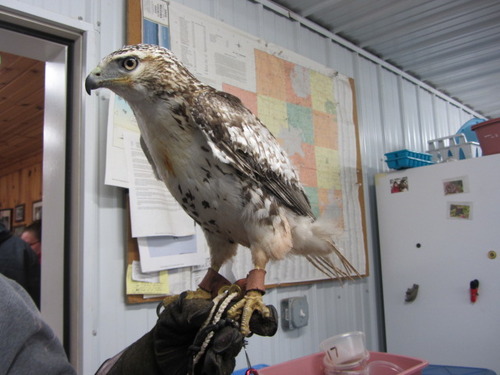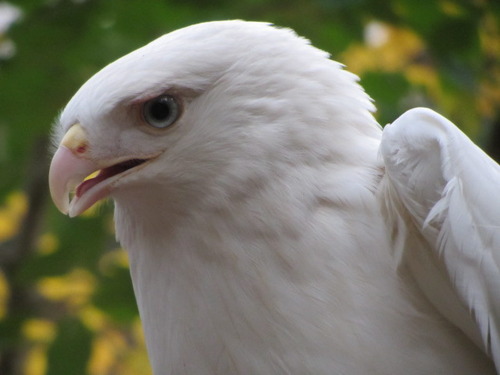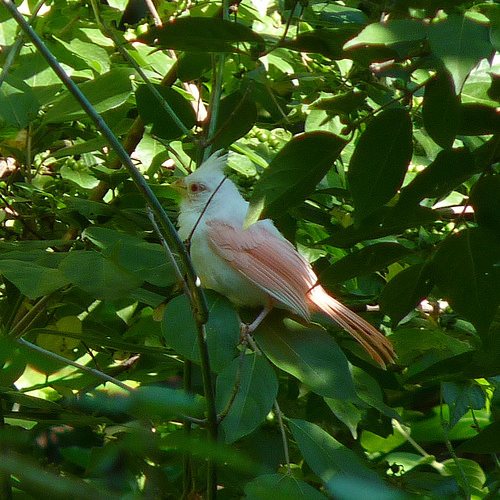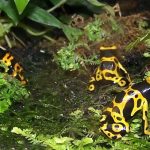Many animals have colorful hair, fur or feathers. Many of these colors are caused by pigments, chemical compounds that absorb and reflect certain wavelengths of visible light. This makes them appear “colorful”.
Sometimes though an animal is completely white, suggesting a lack of pigments. What does it mean to be completely pigmentless? Some animals show the reverse, they are darker than usual and produce too much pigment. Animals of these two extremes, known as albinism and melanism, are viewed as unique and often cause media sensations once discovered. Several years ago, students discovered an albino squirrel on OSU campus which quickly became the unofficial South Campus mascot and a media star, until so named “Whitey” met an early death through a hungry Red-tailed Hawk in 2007. Highlighting the importance of color, which will be the theme for the upcoming Open House (save the date – Saturday April 23rd), we here discuss the lack of colors in some animals.

Red-tailed Hawk demonstrating the importance of camouflage color for survival of squirrels (James Greenebaum 2007)
What is an Albino:
One prominent pigment found in mammals and birds is melanin. Melanin causes a wide range of mainly brown and black colors; it also strengthens the hair or feathers and creates the color we observe in the pupil of the eye. Animals directly manufacture melanin, whereas other pigments, such as carotenoids, have to be taken up through food. Thus in some cases what the animal eats determines its color.
Animals that display albinism cannot produce melanin in their cells, therefore they lack the color patterns we see in their close relatives . Their coloration and skin color are typically pure white. Also, due to their lack of melanin, albino individual’s eyes appear red or pink. Albinism is inherited, so if both parents carry the genes for albinism their offspring may be albino, too. However, not all offspring from an albino parent will be albinistic, some may only carry the gene without any effects.
Myths and Legends of Albinism:
Not every white animal is an albino. Some animals that appear all white may in fact be leucistic. Leucism is a condition characterized by reduced pigmentation, it affects all pigments not only melanin. In this case an individual’s cells have the ability to produce pigments, but not in significant quantities which cause aberrations in color. Animals with leucism have normal or blue eye color, whereas albinistic animals have red eyes. Thus if you see an animal with blue eyes it is not an albino, because blue eyes are an indicator of some melanin. The individual is classified as leucistic. Leucism is an inherited trait just like albinism and can be passed on to offspring.

Leucistic Red-Tailed Hawk
(Stephanie Malinich, 2014)

Note the blue eyes in this leucistic Red-Tailed Hawk
(Stephanie Malinich, 2014)
The terms leucism and albinism are used loosely in defining different aspects of aberrations in individual coloration. Some conditions, such as “progressive greying” and “dilution,” which occur in many bird species are often classified as general leucism, though these traits are not known to be heritable.
We know that albinism is defined as the inability to produce melanin, but that doesn’t stop animals with this condition from having other pigments. Therefore species which take up pigments, such as carotenoids, from food sources may show some coloration. An illustrative example is an albino Northern Cardinal that is primarily white except for feathers with carotenoids, which are red. Note the ultimate indicator that a species is a true albino, red or pink eyes.

Albino Northern Cardinal
(John Beetham, 2014)
Coloration is what animals use to survive, thus animals with albinism and leucism usually have a lower survival rate. Their ability to blend in with their habitat is dramatically reduced and many albinos are easily picked up by predators. Many albino mammals cannot tolerate being exposed to the sun for long periods of time and are likely to develop skin cancers. Albino birds have weakened or easily worn feathers, since they lack the melanin that would typically strengthen their feathers.
In a way living “colorless” has brought more attention to these individuals than if they had been born with the normal coloration of their species. Because of how unique and rare some of these individuals are, people have created organizations such as “The Albino Squirrel Preservation Society”. Zoos will take in albino individuals (Claude the Alligator) to insure a longer life than they would have in the wild. If you’re curious about seeing more albinistic individuals, attend our Open House on April 23rd and see other variations of “Living Colors” in the Museum of Biological Diversity.
About the Author: Stephanie Malinich is Collection Manager of the Tetrapod Collection at the Museum of Biological Diversity.









